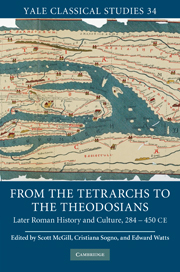Book contents
- Frontmatter
- Contents
- Acknowledgments
- Introduction
- PART I POLITICS, LAW, AND SOCIETY
- PART II BIOGRAPHY AND PANEGYRICS
- PART III FACES OF THEODOSIUS I
- 10 Liar in winter: Themistius and Theodosius
- 11 Moments of truth: Gregory of Nazianzus and Theodosius I
- 12 Reinventing Constantinople: Theodosius I's imprint on the imperial city
- 13 Reinventing history: Jerome's Chronicle and the writing of the post-Roman West
- References
- Index
13 - Reinventing history: Jerome's Chronicle and the writing of the post-Roman West
from PART III - FACES OF THEODOSIUS I
Published online by Cambridge University Press: 04 August 2010
- Frontmatter
- Contents
- Acknowledgments
- Introduction
- PART I POLITICS, LAW, AND SOCIETY
- PART II BIOGRAPHY AND PANEGYRICS
- PART III FACES OF THEODOSIUS I
- 10 Liar in winter: Themistius and Theodosius
- 11 Moments of truth: Gregory of Nazianzus and Theodosius I
- 12 Reinventing Constantinople: Theodosius I's imprint on the imperial city
- 13 Reinventing history: Jerome's Chronicle and the writing of the post-Roman West
- References
- Index
Summary
From Gibbon to Jones and beyond, late Roman historiography observes a period at the year 378. The pause signals not just the disaster of Hadrianople, reckoned as the “beginning of evil” (Rufinus) or the “beginning of the end” (Seeck) for Rome's empire, but also the termination of Ammianus's Res gestae. For Jones, following closely in Gibbon's footsteps, the quality of Ammianus's information merely postponed the moment when the modern historian found himself obliged to rely on “the very inferior narrative of Zosimus, eked out by the three Greek ecclesiastical historians, Socrates, Sozomen and Socrates” and “supplemented by some Latin historians, who lived nearer to the events which they describe, but are wretchedly meagre in content.” Aside from the ecclesiastical histories of Rufinus, Sulpicius Severus, and Orosius, the only Latin historical source worth mentioning at this juncture was “the last two chapters of the Epitome de Caesaribus,” amounting to a few pages on the reigns of Gratian and Theodosius. And yet all was not lost. Disappointing as his strictly historiographical sources for the Theodosian era might be, the modern historian had other stores to fall back on. “The codes,” wrote Jones, “are rich in laws for the whole period” and “the contemporary literature is also abundant.”
In the four decades since Jones's Later Roman Empire appeared, the “law” and “literature” of the Theodosian era have been laid ever more heavily under contribution by late Roman historians. No single scholar's work is more emblematic of that development than John Matthews's.
- Type
- Chapter
- Information
- From the Tetrarchs to the TheodosiansLater Roman History and Culture, 284–450 CE, pp. 265 - 289Publisher: Cambridge University PressPrint publication year: 2010
- 2
- Cited by

